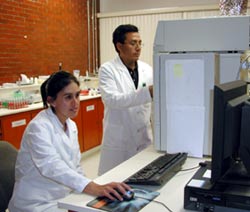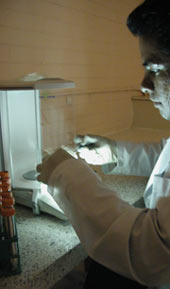CIMMYT E-News, vol 4 no. 2, February 2007
 Breeding knowledge combined with cutting-edge laboratory analysis will produce maize rich in vital nutrients.
Breeding knowledge combined with cutting-edge laboratory analysis will produce maize rich in vital nutrients.
“The link between agriculture and nutrition is surprisingly under-explored,” says Kevin Pixley, who manages the Biofortified Maize for Improved Human Nutrition project at CIMMYT. “Agricultural approaches can contribute to alleviate micronutrient deficiencies, more cheaply and sustainably than food supplements.” The effect is potentially far-reaching: maize is the preferred staple food of more than 1.2 billion people in Sub-Saharan Africa and Latin America. However, maize-based diets, particularly those of the very poor, often lack essential vitamins and minerals. Over 50 million people in these regions are vitamin A deficient, which can lead to visual impairments, blindness and increased child mortality.
Pixley’s project aims to develop varieties of maize that combine high provitamins A, iron and zinc contents with superior agronomic qualities, and disseminate them in partner countries in Africa and Latin America. It is part of HarvestPlus, an international, interdisciplinary program to alleviate nutritional deficiency through breeding micronutrient-enriched staple foods.

The white maize eaten in much of sub-Saharan Africa contains no provitamins A, while standard yellow maize varieties contain about 2 micrograms per gram (µg/g)—still insufficient in a diet dominated by maize. The good news is that there is substantial genetic variation in maize for concentrations of provitamins A. The project has been screening hundreds of maize samples, looking for and then using those with the best provitamins A content. The team has now reached the HarvestPlus program’s intermediate target for maize of 8 µg/g with its current best experimental materials; scientists anticipate producing materials with the ultimate target of 15 µg/g within the next few years by using cutting edge lab tools to help select the best materials for breeding.
The breeding work at CIMMYT is focusing on increasing the concentration of provitamins A in maize. Open-pollinated varieties (OPVs) are being developed using popular varieties grown in partner countries and source materials high in provitamins A. In addition, the project team is developing inbred lines and hybrids with high provitamins A content, based on elite African and Mexican germplasm, which will be freely available to partners for use in producing their own enriched hybrids or OPVs. Providing source materials to other programs is a key part of the project, particularly to key partners Brazil, Ethiopia, Ghana, Guatemala and Zambia, where their performance is tested in local agro-environments.
This work to generate enhanced maize lines relies on accurate measurements of the micronutrient contents of breeding materials at every stage. Therefore, a major aspect of the project has been experimenting with techniques for analyzing carotenoids (which include provitamins A), iron, and zinc.
Carotenoids are a particular challenge to work with, as they are very sensitive to both light and oxygen, making samples vulnerable and difficult to store. Maize scientist Natalia Palacios and her team have adapted and implemented protocols for analyzing carotenoid content using high performance liquid chromatography (HPLC), in collaboration with others in the HarvestPlus network. HPLC is very precise, but it is also expensive and time-consuming.
The team has therefore taken delivery this month of new equipment to measure near-infrared reflectance (NIR). This infrared technique is both accurate and rapid. Collaboration with the International Potato Centre (CIP) has shown that different carotenoid compounds can successfully be differentiated using NIR. The next step for the team is a big push to build on this work. “For us it is a great challenge, and an opportunity to support and enhance the breeding work by providing more and faster information at a lower cost,” says Palacios. The team believes that NIR will multiply their screening potential dramatically: last year they worked at full capacity to analyze 2,000 samples, but with NIR they hope to analyze up to 10,000 per year.
The team will also explore the potential of NIR to measure iron and zinc. Unfortunately, natural variability for iron content in maize is very limited and may be insufficient to breed iron-rich lines, and to an extent the same is true for zinc. However, iron deficiency is an extremely important global problem: it is estimated that nearly three billion people are iron deficient. The team will therefore focus on increasing the bioavailability of iron in maize—i.e. selecting maize with greater amount of iron that can be absorbed by human consumers, rather than with greater absolute amount of iron.
The ultimate goal is to reduce micronutrient malnutrition among maize consumers by providing micronutrient-rich maize varieties that farmers will want to grow and consumers will want to eat.
We’re breaking new ground working on the biofortification of maize,” says Pixley. “This is exciting science.”
For more information, Kevin Pixley, Associate Director, Global Maize Program (k.pixley@cgiar.org)
 Climate adaptation and mitigation
Climate adaptation and mitigation 
